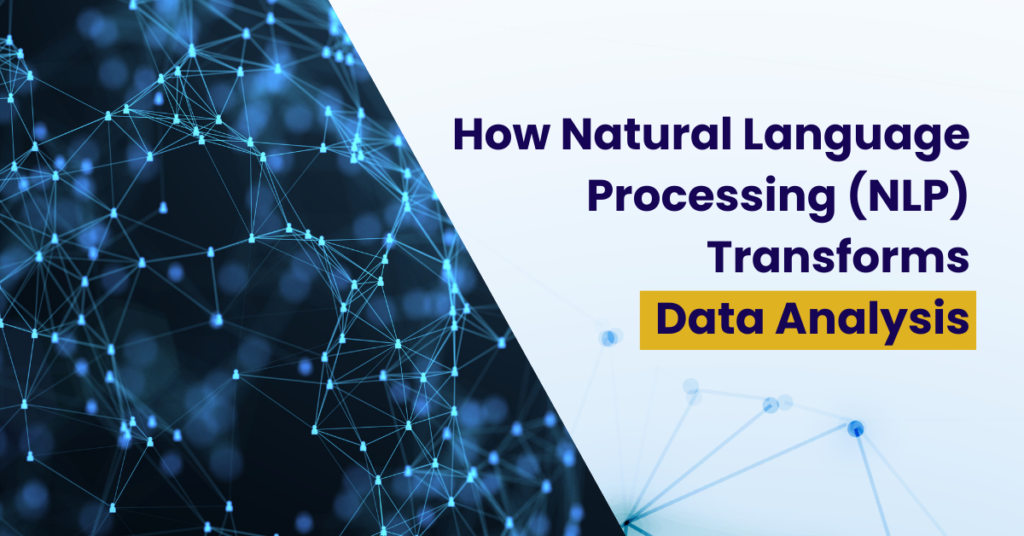Natural Language Processing (NLP) is another branch of AI that combines statistics, computational linguistics, and deep learning models to comprehend human language from spoken or written data. But what about Natural language processing (NLP) in data analysis? One may wonder.
Well, let us tell you that. NLP finds use in various applications such as creating word processors, translation software, search engines, banking applications, and chatbots. In simple language: Its main goal is to understand human language from spoken or written sources.
In this article, we will briefly examine the different aspects of Natural Language Processing In Data Analysis. Join us in on the journey to the world of Natural language processing (NLP) in data analysis.
1. Natural language processing (NLP) in data analysis: Techniques
Natural Language Processing (NLP) techniques have become indispensable tools for data analysts in extracting insights and making sense of vast amounts of textual data.
- Tokenization: Breaking down text into smaller units, such as words or sentences, for analysis.
- Stop Words Removal: Eliminating common words (e.g., “and” “the”) that don’t carry significant meaning for analysis.
- Stemming and lemmatization: Reducing words to their base or root form to normalize variations (e.g., “running” becomes “run”).
- Part-of-Speech Tagging: Assigning grammatical tags to words (e.g., noun, verb) to understand their roles in sentences.
- Named Entity Recognition (NER): Identifying and categorizing named entities such as people, organizations, or locations in text.
- Sentiment Analysis: Determining the sentiment or emotion expressed in the text (e.g., positive, negative, neutral).
- Topic Modeling: Identifying topics or themes within a collection of documents using techniques like Latent Dirichlet Allocation (LDA).
- Word Embeddings: Representing words as dense vectors in a high-dimensional space to capture semantic relationships between words.
- Text Classification: Categorizing text into categories based on its content.
These techniques, among others, enable the extraction of valuable insights from text data in data analysis processes.

2. NLP Tools For Data Analysis
The below-mentioned tools provide a wide range of functionalities for processing and analyzing text data in various domains, to different levels of complexity and requirements when it comes to Natural Language Processing in data analysis.
- NLTK (Natural Language Toolkit): A comprehensive library for NLP tasks such as tokenization, stemming, lemmatization, POS tagging, and more.
- spaCy: An open-source library designed for advanced NLP tasks, offering features like tokenization, POS tagging, dependency parsing, named entity recognition (NER), and sentence segmentation.
- Gensim: Primarily used for topic modeling and document similarity analysis, Gensim provides efficient implementations of algorithms like Latent Semantic Analysis (LSA) and Latent Dirichlet Allocation (LDA).
- TextBlob: A simple and intuitive NLP library built on the NLTK and Pattern libraries, offering sentiment analysis, POS tagging, noun phrase extraction, and more.
- Stanford NLP: A suite of NLP tools for data analysis developed by the Stanford NLP Group, providing capabilities for tokenization, POS tagging, NER, sentiment analysis, and coreference resolution.
- OpenNLP: A Java-based library offering NLP tools for data analysis for tasks such as tokenization, POS tagging, chunking, named entity recognition, and more.
- CoreNLP: Developed by Stanford NLP Group, CoreNLP provides robust NLP capabilities, including tokenization, POS tagging, dependency parsing, NER, sentiment analysis, and coreference resolution.
- SpaCy-ScispaCy: An extension of spaCy tailored for scientific texts, providing specialized NLP functionalities for tasks like entity recognition, relation extraction, and more.
- Pattern: A Python library offering NLP functionalities like tokenization, POS tagging, sentiment analysis, and web mining capabilities.
- BERT (Bidirectional Encoder Representations from Transformers): A state-of-the-art deep learning model for NLP tasks, including text classification, question answering, named entity recognition, and more.
3. Challenges Of NLP In Data Analysis
It goes without saying that the complexity and diversity of human language present numerous challenges for Natural Language Processing (NLP). And when it comes to natural language processing in data analysis, the challenges can be prominent, and they are as follows:
- Ambiguity: Human language is inherently ambiguous, leading to challenges in accurately interpreting meaning, especially in contextually rich data.
- Language differences: Language use varies widely across individuals, cultures, and contexts, making it challenging for NLP systems to generalize across different sets of data.
- Contextual understanding: Understanding language requires grasping context, which can be complex and nuanced, posing difficulties for NLP techniques for data analysis systems, particularly in tasks like sentiment analysis and sarcasm detection.
- Data quality: Poor-quality or ‘noisy data’ can hinder NLP performance, as errors or inconsistencies in the data can propagate through the analysis process.
- Named Entity Recognition (NER): Identifying and categorizing named entities accurately can be challenging, especially in unstructured text data with variations in entity mentions.
- Word sense disambiguation: Resolving the correct meaning of words with multiple meanings based on context is crucial for accurate analysis but remains a challenging task for NLP systems.
- Data sparsity: NLP models often require large amounts of annotated data for training, and acquiring sufficient labeled data can be difficult.
- Domain adaptation: Natural language processing (NLP) in data analysis models trained on one domain may not perform well when applied to a different domain, requiring adaptation or fine-tuning to achieve satisfactory results.
- Bias: NLP systems may reflect and perpetuate biases present in the data, leading to unfair or discriminatory outcomes in data analysis tasks.
- Privacy and ethical concerns: Processing sensitive textual data raises privacy and ethical concerns, necessitating careful consideration of data protection regulations and ethical guidelines.

Conclusion
Natural language processing (NLP) in data analysis stands as a transformative force in the realm of data analysis for sure, offering a unique lens through which to decode the complexity of human language embedded within textual data. Moreover, natural language processing in data analysis bridges the gap between human communication and computational analysis – enabling data analysts with valuable insights, patterns, and sentiments hidden within layers and layers of text.





